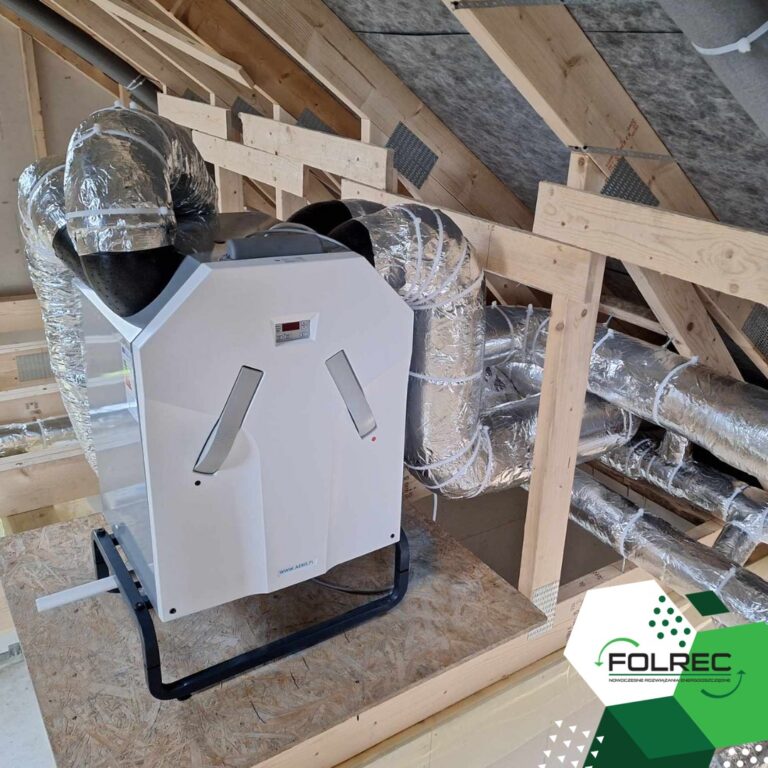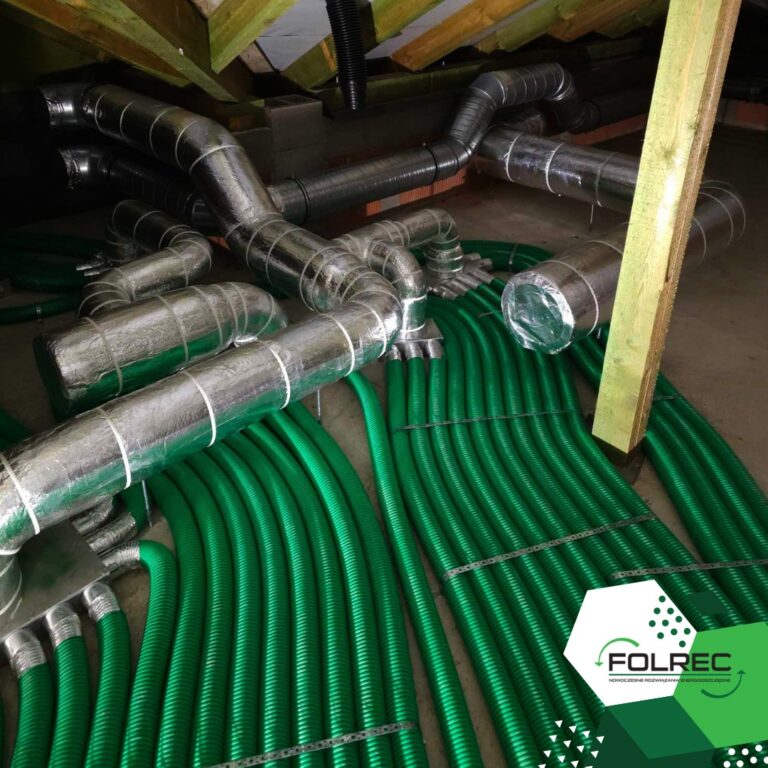FOLREC Heat Recovery System. Design Service Installation of recuperators. What is recuperation?
Recuperation is a mechanical ventilation system with heat recovery. Its heart is a device called a recuperator. This system draws fresh air from outside the building and distributes it through ducts throughout the rooms. At the same time, it extracts the stale air and throws it outside. Fresh air, through the heat exchanger in the recuperator, comes into contact (but does not mix) with the removed air, heating or cooling depending on the season.
In winter, up to 94% of heat can be recovered this way!
Mamy na swoim koncie tysiące realizacji w całej Polsce oraz za granicą. ZOBACZ JE, KLIKNIJ TUTAJ








In addition to minimizing heat loss during the heating season, heat recovery allows maintaining high air quality inside the building. It is particularly useful in modern, well-insulated buildings where natural ventilation is insufficient. Mechanical ventilation with heat recovery is an investment that brings many benefits. It is worth emphasizing that this applies not only to economic issues, but also to health issues. Thanks to this process, the air is cleansed of dust, bacteria and other pollutants, which has a positive effect on human health. By saving energy, we also contribute to environmental protection.
Advantages of using heat recovery
1. Replacing used air.
2. Filtration of the supplied air.
3. Savings on heating.
4. Possibility to control the amount of air.
5. Possibility to install a ground heat exchanger.
6. Investment savings.
Rules applicable when installing heat recovery
1. Project supported by calculations for a given building.
2. Place of installation of the recuperator.
3. Selection of a recuperator.
4. Selection of installation.
5. How to perform the installation.
6. Tightness of windows.
7. Ventilation holes in doors or door cuts.
We invite you to read the opinions of our customers who already use heat recovery in Greater Poland. Our company has installed heat recovery systems in the largest cities in our region, so you will find opinions about our heat recovery installations in Jarocin, Pleszew, Ostrów Wielkopolski, Poznań and Kalisz. We invite you!
We are a company that specializes in the design, installation and service of heat recovery. Thanks to our knowledge and experience, we can offer our clients the highest quality services in this area. We design ventilation systems in accordance with the needs of our clients, taking into account their individual requirements, applicable regulations and the characteristics of the building. Installation of heat recovery is also one of our specializations. We make every effort to ensure that it is carried out in accordance with norms and standards, as well as customer expectations.
We also offer maintenance services to ensure the reliability and continuity of operation of ventilation systems to our customers. Our qualified employees will perform comprehensive diagnostics, regular technical inspections, and, if necessary, also repair or replacement of recuperator parts.
MOST IMPORTANT QUESTIONS REGARDING HEAT RECOVERY SYSTEM
Heat recovery system works by mechanically replacing stale air with fresh air taken from outside the building. During this process, heat is recovered from the air taken from inside the building.
The heart of the heat recovery system is the ventilation unit, i.e. the heat recovery unit. In it, or more precisely in the heat exchanger, where air streams taken from both outside and inside the building meet. However, the streams do not mix with each other because each of them flows through a separate channel. The air taken from the building, passing through the exchanger, gives up its heat, while the air taken from outside receives it. Finally, clean and heated air is distributed through ventilation ducts throughout the building, and the used air is thrown outside.
Mechanical and gravity ventilation
Mechanical ventilation differs from gravity ventilation in that it not only ventilates rooms, but also cleans them of impurities and recovers heat from previously used air.
Gravity ventilation pulls air out of the house, losing its heat. At the same time, through leaks, such as gaps in windows and doors or ventilation grills, cold (in winter) and unpurified air is drawn in from outside.
Heat recovery system and modern construction
Nowadays, when building a house, we focus on making it energy-saving, i.e., above all, “hermetic” (so that our accumulated heat does not escape). Unfortunately, gravity ventilation does not guarantee this. As we wrote earlier, it involves air exchange through gaps in the house. In the case of an energy-efficient house, there are practically no gaps. When building an energy-efficient house, heat recovery saystem becomes a necessity! Thanks to it, we have ventilation without losing heat.
It is best to start thinking about heat recovery system at the stage of building the house. If we decide to install heat recovery system in a house that has already been built, it will involve higher costs.
At the time of construction, all you need to do is install the system. You don’t need to have a recuperator yet. At the beginning, it is enough to arrange the appropriate channels and secure the place where the recuperator is to be installed.
Generally speaking, heat recovery system takes care of our health, increases the comfort of staying at home and saves energy. Taking a more detailed approach, we can talk about such advantages as:
- air filtering, which significantly reduces the amount of dust and various types of harmful pollen, mites, viruses and bacteria in the home,
- air purification from smoke, exhaust gases, etc.,
- moisture removal,
- quick removal of odors, e.g. cooked food in the kitchen or unpleasant odors coming from the toilet,
- faster drying of laundry and floors after washing,
- full control over the amount of supply and exhaust air,
- reducing the number of insects in the house and reducing noise from outside (this is due to the lack of need to open windows),
- possibility of expanding the installation with air insulation and cooling systems,
- automation of the ventilation process thanks to CO2 and humidity sensors,
- possibility of connection to smart home installations,
- increasing the standard of the house, and therefore also its value,
- reducing heating costs thanks to heat recovery.
Is heat recovery system essential?
Ventilation in the house is essential. We can choose between gravity and mechanical. We have already mentioned the disadvantages of the first one and the advantages of the other. All this makes us sure that it is worth investing in mechanical ventilation with heat recovery.
The first stage is the distribution of ventilation ducts. We do this when the building is in a closed shell state. We can place them in a suspended ceiling or in the ceiling insulation layer. We use channels made of steel or plastic, depending on the specificity of a given building. Each solution has its advantages:
– channels made of galvanized steel, popularly called SPIRO, are characterized by high durability and resistance to mechanical factors, UV radiation, high temperatures and humidity. Steel channels have fire-resistant properties and are safe for use in single- and multi-family houses,
– channels made of polyethylene, a durable material that is very difficult to damage. This system consists of steel ventilation fittings and round smooth plastic ducts with an antibacterial coating with silver ions protecting the interior of the installation against unwanted bacteria.
The second stage of implementation is the installation of the heat recovery unit. We install all types of AHUs, but we mainly use brands such as: AERIS, WANAS, KOMFOVENT and DEFRO. They are characterized by high quality, reliability, are quiet, effective and can be controlled from mobile applications.
The last stage is system adjustment. For the system to work properly, remember to service your recuperator annually and replace the filters systematically (approximately every 6 months). This will increase the life of the system and the quality of its operation.
The most common mistake made when installing a heat recovery system is the lack of a professional design and the fact that it was undertaken by people who do not have the appropriate knowledge, experience and skills. More and more often, there are situations in which installations are made by unqualified people, and investors only then look for a reliable company to repair the errors, which, of course, results in an unnecessary increase in investment outlays.
Another common mistake is insufficient insulation of ventilation ducts. As a result, recuperation does not use its efficiency and recovers too little heat. In extreme cases, this may lead to the failure of the recuperator.
Another common mistake is the inappropriate selection of ventilation duct diameters. As a result, heat recovery becomes noisy and has a negative impact on the well-being of household members by not supplying the appropriate amount of air.
By choosing a professional company with many years of experience to install the heat recovery system, we can avoid such mistakes.
Call our specialists and ask about heat recovery system for your home.
We help you choose the right heat recovery unit, we design and finally we install and run the entire system in your home.
